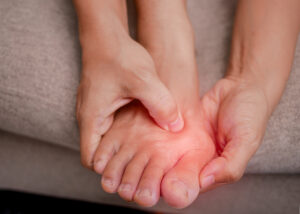By Gabrielle Lee-Kim, DPM, AACFAS
What is a Bunion?
A bunion, also known as hallux abducto valgus deformity (HAV), is the visible bump on the side of the first toe joint that causes discomfort, pain, redness, swelling at the joint when it moves or when it rubs against the shoe.

Since the toe joints have to move with every step we take, this deformity can progress due to biomechanics. When the deformity progresses, the big toe drifts towards the second toe and causes overlapping and underlapping of the second toe. When the deformity is mild, various conservative treatments can be used to manage symptoms that include but are not limited to shoe gear modifications, bunion shields, padding, NSAIDS, and custom foot orthosis.
However, when the deformity progresses to moderate/severe, conservative treatments may not be sufficient to control symptoms. In this case, surgical intervention is indicated.
Treating a Bunion
For these moderate to severe bunion deformities, patients can significantly benefit from surgical intervention because it can completely resolve the symptoms and stop progression. Some of the newer techniques for bunion surgery entail minimally invasive surgery (MIS) with robust internal fixation constructs so recovery is quicker and less painful. A period of non-weight bearing on the surgical limb is shorter or even none because patients are able to ambulate out of the surgery in a CAM walker. After 2-3 weeks, patients can wear sneakers to ambulate and after 3-4 weeks, they are in any type of shoes in full activity level.
Due to the advancement of the fixation constructs with two plates in two different planes, patients can put weight on the foot quicker even with the more invasive surgery techniques such as fusion at the joint between base of the long bone and midfoot bone (Lapidus procedure). After 3 weeks, patients ambulate in a CAM walker and after 6 weeks in sneakers.
Bunion Deformity
Commonly, when patients have bunion deformity, the big toe pushes the second toe and causes hammertoe deformity at the second digit. If no intervention is done in a timely manner, the other digits can subsequently develop hammertoe deformities. When this happens, it is beneficial for the patients to undergo hammertoe repair in conjunction with the bunion surgery.
Just like bunion surgery, the hardware system is much better and hammertoe surgeries rarely require a period of non-weight bearing anymore. Hammertoe surgeries are broadly divided into joint sparing procedures or joint fusion procedures. When deformity is flexible, joint sparing procedure to remove a part of a toe bone can be done which rarely requires hardware and patients can ambulate in a surgical shoe right away. When rigid hammertoes are being treated surgically, joint fusion is considered with either a screw or pin. These implants have developed tremendously in that they help with proper, quicker fusion at the joint by firmly holding the osteotomy.
After these bunion and hammertoe repairs are performed, patients are able to wear any types of shoes without pain. The joints are well aligned so the walking is better and patients can participate in any activities that were previously hindered by the foot pain. Patient’s overall quality of life is enriched.





